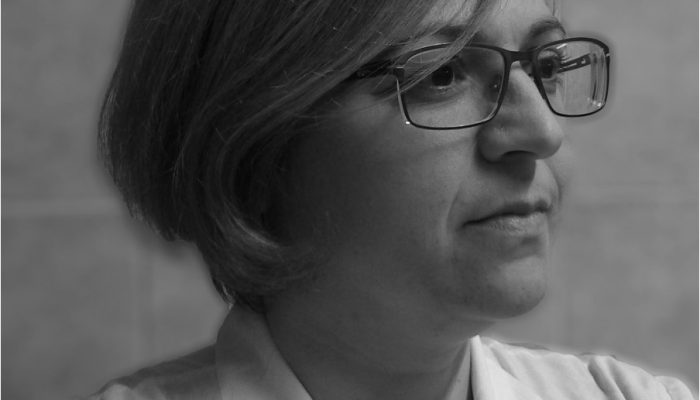Dr. Rodopi Stamatiou is a researcher at the Department of Medicine of the University of Thessaly. She started her studies at the Department of Biology of the Aristotle University of Thessaloniki and was awarded a PhD by the University of Thessaly. Through numerous publications in international journals, scholarships and scientific conferences, Rodopi has specialized and is internationally recognized for her work in lung physiology.
She recently published her study on airway smooth muscle cells and galamine with an all-female researchers team! More specifically, Rodopi studied smooth muscle cells of the trachea which is the largest airway axis in the respiratory system. Patients with chronic inflammatory bowel disease such as asthma and COPD (chronic obstructive pulmonary disease) are often given anti-muscarinic receptors to help bronchodilate and thus aid breathing. In bronchial diseases, the airways constrict due to the increase in the volume and number of smooth muscle cells, but also due to the hyperresponsiveness of these cells to stimuli that cause contraction, so that not enough air passes into the lungs. In addition, changes in these cells can lead to permanent airway wall remodeling and permanent airway dysfunction. Therefore, if these cell-specific reactions can be reduced, the symptoms could potentially be reduced in the long run. Rodopi and her colleagues studied a classic muscarinic receptor antagonist, galamine, and its effect on smooth muscle cells. Its results showed that galamine is directly related to the uncontrolled proliferation of smooth muscle cells and acts through the PI3K and MAPK signaling pathways. This opens a new way to treat chronic inflammatory diseases of the respiratory tract with possibly more targeted drugs to treat the cause and not just the symptoms of these diseases.
Along with her work as a researcher, Rodopi is a mother of two and she has recently joined our team of mentors to offer young science girls advice and career support.
Rodopi discussed with us about her research, the new protocols she creates and her life as a researcher in Greece.
What are the smooth muscle cells and how did they gain your interest in devoting your research to their study?
Smooth muscle cells are a structural component of the walls of the airways and blood vessels. Their ability to contract regulates the diameter of these ducts, while at the same time their secretory activity contributes to the mechanisms of development of inflammation and injury repair in the ducts caused by chronic inflammation. They are a cell type that shows great plasticity and does not make a final differentiation but it depends on the stimuli to which it is exposed. This is amazing from a biological point of view. For many years the function and involvement of smooth muscle cells in the pathophysiology of the respiratory system was underestimated, which made me more motivated to devote myself to the study of smooth muscle cells, as there was a large knowledge gap in this field.
Why is it so difficult to treat bronchitis and doctors continue to prescribe drugs to partially relieve their symptoms?
I find that the mechanisms involved in airway dysfunction are particularly complex, involving different cell types as well as immunobiological responses. This interaction combined with the differences that occur in different stages of respiratory diseases, but also the uniqueness of the respiratory from person to person, make in-depth treatment difficult and the easy and effective solution is only symptomatic treatment.
What is your opinion on personalized treatments?
I believe that it will be a one-way street in the coming years, as it has become clear that the uniqueness of each patient makes the therapeutic approach more targeted and efficient. The goal should be the treatment of the specific patient and not the treatment of the disease in all patients. Special people also require separate treatment regimens.
We now have access to entire single cell transcripts from various organisms, why can’t we still find targeted therapies?
The transition to more targeted therapies and personalized drugs requires the creation of two main axes. Initially, it demands the focus of the scientific community on the uniqueness of the patient and in addition the shift of health systems in their treatment. These conditions are the challenge for the future of research and the creation of more efficient public health systems. I believe that science has begun to change and that health systems will inevitably follow this trend.
The lung is one of the most complex organs in our body. What direction do you think research will take in the coming years for the relief / treatment of lung diseases.
Attempts are already being made to develop drugs with specialized action in relation to the genetic profile of patients, which partialy determines both the symptomatology and the response to treatment regimens. I believe that research aimed at preventing lung diseases, through the identification of high-risk groups, but also timely interventions to minimize the aggravating factors, will also play an important role. At the same time, I believe that researchers will continue to strive to understand and elucidate the mechanisms of respiratory pathology.
What are you working on right now?
For the past 2 years, my research team and I have been developing a technique for obtaining and processing bronchial secretions from intubated patients in mechanical ventilation in intensive care units. This technique allows the rapid and immediate assessment of inflammation in the respiratory tract of these patients and the further assessment of the effectiveness of the therapeutic approach followed in each of them. In addition, it is an important tool in the early diagnosis of “respiratory pneumonia”, which is essentially due to colonization of the lung by microbes due to intubation and is one of the common causes of deterioration of the clinical picture and death of patients admitted to ICU.
Which stages are different compared to previous protocols?
Our method is different in the aspects of means for taking lung secretions, the mucus dissolution process, and the tests performed on the sample. The development of this technique is a prime example of clinical and basic research collaboration.
What are the advantages of the new protocol compared to what exists so far?
Initially, the way secretions are taken is less burdensome for patients than the techniques such as taking BAL (bronchoalveolar lavage) used today. In addition, sample processing time is almost half of common practice. However, the most important advantage of the technique is that during the processing of each sample there is no chemical treatment performed, as a result we have at our disposal bronchial secretions in which a wide range of tests can be performed, such as determination of proteins, mainly inflammatory factors, development and study of cell profile of the sample, but also complete microbial control, without any restrictions. Thus, the physician has in his hands a fast, effective and with a wide range of answers technique, which can help him choose a suitable treatment regimen for his patient.
How could a company/hospitals take advantage of it?
I believe that in its final form the technique will be able to be automated both in terms of sample processing and tests that will be performed on each sample. So creating an “easy to use kit” I think would be ideal for a company.
Has the university supported you to benefit commercially from your discovery? Is there such a possibility?
The University’s support is currently limited to the provision of research equipment and materials and the approval and acceptance of the research protocol. In the future, there may be potential for commercial benefits through University support in an innovation competition. We wait, we search and we continue unscathed.

RELATED ARTICLES
CONTACT US
____________
greekwomeninstem@gmail.com
Do you have ideas, questions, comments or special requests?
Would you like to highlight your research project or nominate a researcher that you would like to learn more about?
Please write to our email or fill out the form and hit “send”. We will be happy to talk with you!
[contact-form-7 id=”44″ title=”Contact form 1″]
